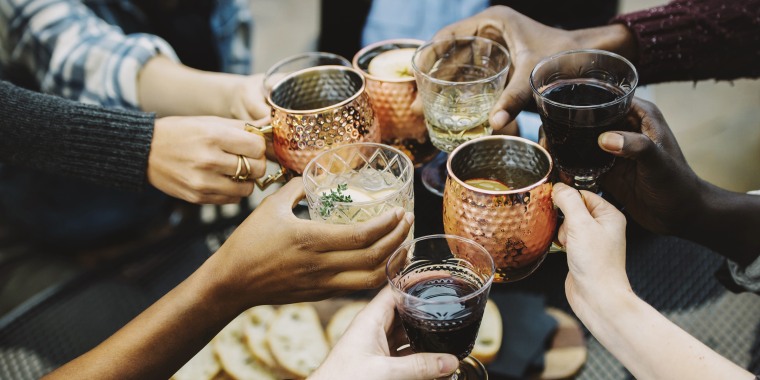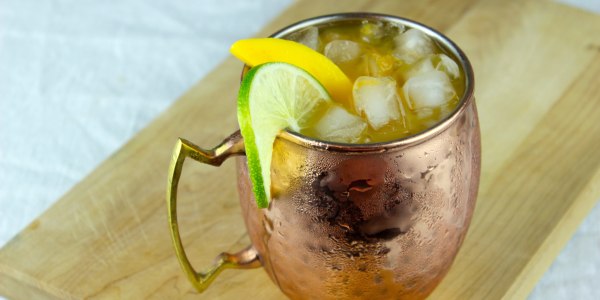We've already been warned that drinking cocktails out of copper mugs may be dangerous, but it turns out that there are plenty of other potentially poisonous combos when it comes to trendy libations.
In 2017, when the Iowa Alcoholic Beverages Division issued an advisory warning that said pure copper mugs are bad drinking vessels, a shocked sadness fell upon the many makers — and drinkers — of pretty cocktails like Moscow mules.
Thankfully, the advisory clarified that the mugs are safe if the insides are lined with a different type of metal, like steel, or any other material that would act as a barrier between the copper and the alcoholic beverage.
Unfortunately, copper isn't the only potentially harmful material being used behind bars these days. Instagram-worthy cocktails are in, so experimentation has become a trick of the trade for many avant-garde mixologists.
From flaming drinks — like the ones that set customers on fire at Gordon Ramsay's restaurant — to various herbal concoctions, many bartenders are pushing the limit between tasty and toxic.
For example, bergamot, a floral citrus fruit that's similar to bitter orange, has the ability to make foods and drinks pretty tasty. But it also has the potential to cause burns and blisters if it comes in contact with skin and is then exposed to sunlight for a long period of time. Celery, dill, parsley and other citrus fruits like limes can also cause this condition called photosensitivity.
There are dozens of other potentially hazardous ingredients circulating the mixology scene now, including wild ginger, various types of flowers, licorice, nutmeg, mushrooms, sassafras and tomato leaves.
In addition to ingredients, certain drinking vessels — like old tiki cups or ceramic mugs — may have traces of lead in the glaze.
But don't swear off happy hour just yet.
Camper English, a San Francisco-based drink journalist and alcohol expert, created an encyclopedic-like solution to navigating potentially harmful ingredients: It's called CocktailSafe.org. The website is intended for bartenders, but it's also helpful for consumers who might be perusing a bar's drink menu. It's also handy for those who enjoy crafting new cocktails at home.
The site has an A-to-Z index of ingredients, tools and techniques which may produce negative effects if handled in a certain way, mixed with other items, used in a particular amount ... or used at all. Each item (currently, there are about 60, though CocktailSafe.org is a work in progress) links to an ingredient's page, which describes how it's typically used, why it may be harmful and, if applicable, how to use it safely.
Camper told TODAY Food that he also provides the "legal and health status" of ingredients, Food and Drug Administration (FDA) recommendations, and links to articles to support evidence.
"I started thinking more about cocktail safety a few years ago when a woman in the U.K. was served a shot with liquid nitrogen in it, and had to have her stomach removed in order to save her life," Camper told TODAY. "Luckily, incidents like that are incredibly rare, but I've known bartenders who've made themselves ill with tobacco-infused alcohol and homemade tonic syrup, and many recipes for bitters and infusions in old cocktail books from the 1800s often call for ingredients that have since been disallowed for use in food and beverages in the U.S."
When asked about specific new ingredients that probably shouldn't be used, Camper said he thinks that tobacco is one of the more disconcerting ingredients being used today. When mixed directly with craft cocktails containing alcohols like rum or whiskey, ingesting it delivers more nicotine into the body than smoking.
Another trendy ingredient that's been celebrated by the wellness community may actually do more harm than good: activated charcoal. The dark black powder may give drinks a spooky deep color but due to its absorbent properties, it may make any medication you take less effective.
Camper hopes bartenders will use his site as a free resource to guide them the process of drink-making when exploring new recipes.
Today, whenever he sees something of concern on a menu, Camper sends the bar or restaurant a "polite email" linking to the ingredient on CocktailSafe.org. He will also provide some alternatives to said ingredients that are less likely to cause any harm.
Said Camper, "So far, that's been very effective."



